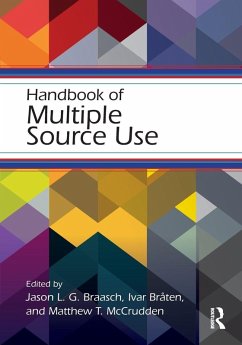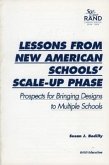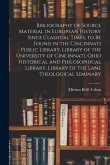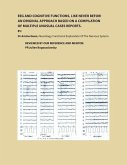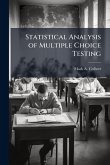Handbook of Multiple Source Use
Herausgeber: Braasch, Jason L. G.; McCrudden, Matthew T.; Bråten, Ivar
Handbook of Multiple Source Use
Herausgeber: Braasch, Jason L. G.; McCrudden, Matthew T.; Bråten, Ivar
- Broschiertes Buch
- Merkliste
- Auf die Merkliste
- Bewerten Bewerten
- Teilen
- Produkt teilen
- Produkterinnerung
- Produkterinnerung
The Handbook of Multiple Source Use draws on theory and research within cognitive and educational psychology, the learning sciences, disciplinary education, information literacy, reading psychology, and social psychology, to present the first comprehensive research volume on this topic.
Andere Kunden interessierten sich auch für
![PRAXIS Elementary Education Multiple Subjects Mathematics PRAXIS Elementary Education Multiple Subjects Mathematics]() Lq PublicationsPRAXIS Elementary Education Multiple Subjects Mathematics63,99 €
Lq PublicationsPRAXIS Elementary Education Multiple Subjects Mathematics63,99 €![Multiple Assessments for Multiple Intelligences Multiple Assessments for Multiple Intelligences]() James BellancaMultiple Assessments for Multiple Intelligences41,99 €
James BellancaMultiple Assessments for Multiple Intelligences41,99 €![Lessons from New American Schools' Scale-Up Phase: Prospects for Bringing Designs to Multiple Schools Lessons from New American Schools' Scale-Up Phase: Prospects for Bringing Designs to Multiple Schools]() Susan BodillyLessons from New American Schools' Scale-Up Phase: Prospects for Bringing Designs to Multiple Schools19,99 €
Susan BodillyLessons from New American Schools' Scale-Up Phase: Prospects for Bringing Designs to Multiple Schools19,99 €![Bibliography of Source Material in European History Since Classical Times, to Be Found in the Cincinnati Public Library, Library of the University of Bibliography of Source Material in European History Since Classical Times, to Be Found in the Cincinnati Public Library, Library of the University of]() Miriam Bellé UrbanBibliography of Source Material in European History Since Classical Times, to Be Found in the Cincinnati Public Library, Library of the University of15,99 €
Miriam Bellé UrbanBibliography of Source Material in European History Since Classical Times, to Be Found in the Cincinnati Public Library, Library of the University of15,99 €![Eeg and Cognitive Functions, Like Never Befor!: An Original Approach Based on a Compilation of Multiple Unusual Cases Reports Eeg and Cognitive Functions, Like Never Befor!: An Original Approach Based on a Compilation of Multiple Unusual Cases Reports]() Amine GuenEeg and Cognitive Functions, Like Never Befor!: An Original Approach Based on a Compilation of Multiple Unusual Cases Reports122,99 €
Amine GuenEeg and Cognitive Functions, Like Never Befor!: An Original Approach Based on a Compilation of Multiple Unusual Cases Reports122,99 €![Statistical Analysis of Multiple Choice Testing Statistical Analysis of Multiple Choice Testing]() Mark A ColbertStatistical Analysis of Multiple Choice Testing15,99 €
Mark A ColbertStatistical Analysis of Multiple Choice Testing15,99 €![Storytelling in Emergent Literacy: Fostering Multiple Intelligence Storytelling in Emergent Literacy: Fostering Multiple Intelligence]() Susan Louise TrostleStorytelling in Emergent Literacy: Fostering Multiple Intelligence92,99 €
Susan Louise TrostleStorytelling in Emergent Literacy: Fostering Multiple Intelligence92,99 €-
-
-
The Handbook of Multiple Source Use draws on theory and research within cognitive and educational psychology, the learning sciences, disciplinary education, information literacy, reading psychology, and social psychology, to present the first comprehensive research volume on this topic.
Produktdetails
- Produktdetails
- Verlag: Routledge
- Seitenzahl: 562
- Erscheinungstermin: 6. März 2018
- Englisch
- Abmessung: 254mm x 178mm x 30mm
- Gewicht: 1043g
- ISBN-13: 9781138646605
- ISBN-10: 1138646601
- Artikelnr.: 51737707
- Herstellerkennzeichnung
- Libri GmbH
- Europaallee 1
- 36244 Bad Hersfeld
- gpsr@libri.de
- Verlag: Routledge
- Seitenzahl: 562
- Erscheinungstermin: 6. März 2018
- Englisch
- Abmessung: 254mm x 178mm x 30mm
- Gewicht: 1043g
- ISBN-13: 9781138646605
- ISBN-10: 1138646601
- Artikelnr.: 51737707
- Herstellerkennzeichnung
- Libri GmbH
- Europaallee 1
- 36244 Bad Hersfeld
- gpsr@libri.de
Jason L. G. Braasch is Assistant Professor of Psychology and Affiliate of the Institute for Intelligent Systems at the University of Memphis, USA. Ivar Bråten is Professor of Educational Psychology at the University of Oslo, Norway. Matthew T. McCrudden is Associate Professor of Educational Psychology at Victoria University of Wellington, New Zealand.
Chapter 1. Introduction to research on multiple source use (Jason L. G.
Braasch, Ivar Bråten, Matthew T. McCrudden) Section 1. Theoretical
Frameworks Chapter 2. Representations and processes in multiple source use
(M. Anne Britt, Jean-François Rouet, and Amanda Durik) Chapter 3. Cold and
warm perspectives on the Cognitive Affective Engagement Model of multiple
source use (Alexandra List and Patricia A. Alexander) Chapter 4. Towards a
New Literacies perspective of synthesis: Multiple source meaning
construction (Douglas K. Hartman, Michelle S. Hagerman, and Donald J. Leu)
Chapter 5. A social psychology perspective on multiple source use:
Elaboration and persuasion (Duane T. Wegener, Kathleen M. Patton, and
Curtis P. Haugtvedt) Section 2. Individual Differences, Cognitive
Mechanisms, and Contextual Factors in Multiple Source Use Chapter 6.
Individual differences in multiple document comprehension (Sarit Barzilai
and Helge I. Strømsø) Chapter 7. Potential challenges of Internet use among
readers with dyslexia (Øistein Anmarkrud, Eva Wennås Brante, and Anette
Andresen) Chapter 8. Strategic processing in accessing, comprehending, and
using multiple sources online (Byeong-Young Cho, Peter Afflerbach, and
Hyeju Han)Chapter 9. The role of validation in multiple documents
comprehension (Tobias Richter and Johanna Maier) Chapter 10. Text relevance
and multiple source use (Matthew T. McCrudden) Chapter 11. The role of
conflict in multiple source use (Ivar Bråten and Jason L. G. Braasch)
Section 3. Multiple Source Use in Specific Content Areas Chapter 12.
Multiple source use in history (Emily Fox and Liliana Maggioni) Chapter 13.
Functional scientific literacy: Disciplinary literacy meets multiple source
use (Iris Tabak) Chapter 14. The role of sourcing in mathematics (Keith
Weber) Chapter 15. Multiple source use when reading and writing in
literature/language arts in classroom contexts (David Bloome, Minjeong Kim,
Huili Hong, and John Brady) Section 4. Multiple Source Use Beyond the
Classroom (section editor: Matt) Chapter 16. The provenance of certainty:
Multiple source use and the public engagement with science (Rainer Bromme,
Marc Stadtler, Lisa Scharrer) Chapter 17. Non-academic multiple source use
on the Internet (Ladislao Salmerón, Yvonne Kammerer, and Pablo Delgado)
Chapter 18. Updating of character information when reading multiple sources
for pleasure (Amalia M Donovan and David N. Rapp) Chapter 19.
Self-regulated learning processes and multiple source use in and out of
school (Jeffrey A. Greene, Dana Z. Copeland, Victor M. Deekins, and Rebekah
Freed) Section 5. Multiple Source Use Interventions (section editor: Ivar)
Chapter 20. Effects of instructional conditions on comprehension from
multiple sources in history and science (Jennifer Wiley, Allison J. Jaeger,
and Thomas D. Griffin) Chapter 21. Learning to read while reading to learn:
The central role of multiple documents in two instructional programs (Lowry
Hemphill and Catherine Snow) Chapter 22. Promoting multiple text
comprehension through motivation in the classroom (John T. Guthrie) Chapter
23. Instruction to promote information-problem solving on the Internet in
primary and secondary education students: A systematic literature review
(Saskia Brand-Gruwel and Johan L. H. van Strien) Section 6. Assessment of
Multiple Source Use (section editor: Ivar) Chapter 24. Complementary
methods for assessing online processing of multiple sources (Lucia Mason
and Elena Florit) Chapter 25. Scenario-based assessment of multiple source
use (John Sabatini, Tenaha O'Reilly, Zuowei Wang, and Kelsey Dreier)
Chapter 26. Assessment of multiple resource comprehension and information
problem solving (Susan R. Goldman, Alyssa Blair, and Candice M. Burkett)
Chapter 27. Assessing online collaborative inquiry and social deliberation
skills as learners navigate multiple sources and perspectives (Julie Coiro,
Jesse R. Sparks, and Jonna M. Kulikowich) Chapter 28. Computer-based
assessment of essays based on multiple documents: Evaluating the use of
sources (Joseph P. Magliano, Peter M. Hastings, Kristopher Kopp, Dylan
Blaum, and Simon Hughes) Chapter 29. Reflections and future directions
(Jason L. G. Braasch, Matthew T. McCrudden, and Ivar Bråten)
Braasch, Ivar Bråten, Matthew T. McCrudden) Section 1. Theoretical
Frameworks Chapter 2. Representations and processes in multiple source use
(M. Anne Britt, Jean-François Rouet, and Amanda Durik) Chapter 3. Cold and
warm perspectives on the Cognitive Affective Engagement Model of multiple
source use (Alexandra List and Patricia A. Alexander) Chapter 4. Towards a
New Literacies perspective of synthesis: Multiple source meaning
construction (Douglas K. Hartman, Michelle S. Hagerman, and Donald J. Leu)
Chapter 5. A social psychology perspective on multiple source use:
Elaboration and persuasion (Duane T. Wegener, Kathleen M. Patton, and
Curtis P. Haugtvedt) Section 2. Individual Differences, Cognitive
Mechanisms, and Contextual Factors in Multiple Source Use Chapter 6.
Individual differences in multiple document comprehension (Sarit Barzilai
and Helge I. Strømsø) Chapter 7. Potential challenges of Internet use among
readers with dyslexia (Øistein Anmarkrud, Eva Wennås Brante, and Anette
Andresen) Chapter 8. Strategic processing in accessing, comprehending, and
using multiple sources online (Byeong-Young Cho, Peter Afflerbach, and
Hyeju Han)Chapter 9. The role of validation in multiple documents
comprehension (Tobias Richter and Johanna Maier) Chapter 10. Text relevance
and multiple source use (Matthew T. McCrudden) Chapter 11. The role of
conflict in multiple source use (Ivar Bråten and Jason L. G. Braasch)
Section 3. Multiple Source Use in Specific Content Areas Chapter 12.
Multiple source use in history (Emily Fox and Liliana Maggioni) Chapter 13.
Functional scientific literacy: Disciplinary literacy meets multiple source
use (Iris Tabak) Chapter 14. The role of sourcing in mathematics (Keith
Weber) Chapter 15. Multiple source use when reading and writing in
literature/language arts in classroom contexts (David Bloome, Minjeong Kim,
Huili Hong, and John Brady) Section 4. Multiple Source Use Beyond the
Classroom (section editor: Matt) Chapter 16. The provenance of certainty:
Multiple source use and the public engagement with science (Rainer Bromme,
Marc Stadtler, Lisa Scharrer) Chapter 17. Non-academic multiple source use
on the Internet (Ladislao Salmerón, Yvonne Kammerer, and Pablo Delgado)
Chapter 18. Updating of character information when reading multiple sources
for pleasure (Amalia M Donovan and David N. Rapp) Chapter 19.
Self-regulated learning processes and multiple source use in and out of
school (Jeffrey A. Greene, Dana Z. Copeland, Victor M. Deekins, and Rebekah
Freed) Section 5. Multiple Source Use Interventions (section editor: Ivar)
Chapter 20. Effects of instructional conditions on comprehension from
multiple sources in history and science (Jennifer Wiley, Allison J. Jaeger,
and Thomas D. Griffin) Chapter 21. Learning to read while reading to learn:
The central role of multiple documents in two instructional programs (Lowry
Hemphill and Catherine Snow) Chapter 22. Promoting multiple text
comprehension through motivation in the classroom (John T. Guthrie) Chapter
23. Instruction to promote information-problem solving on the Internet in
primary and secondary education students: A systematic literature review
(Saskia Brand-Gruwel and Johan L. H. van Strien) Section 6. Assessment of
Multiple Source Use (section editor: Ivar) Chapter 24. Complementary
methods for assessing online processing of multiple sources (Lucia Mason
and Elena Florit) Chapter 25. Scenario-based assessment of multiple source
use (John Sabatini, Tenaha O'Reilly, Zuowei Wang, and Kelsey Dreier)
Chapter 26. Assessment of multiple resource comprehension and information
problem solving (Susan R. Goldman, Alyssa Blair, and Candice M. Burkett)
Chapter 27. Assessing online collaborative inquiry and social deliberation
skills as learners navigate multiple sources and perspectives (Julie Coiro,
Jesse R. Sparks, and Jonna M. Kulikowich) Chapter 28. Computer-based
assessment of essays based on multiple documents: Evaluating the use of
sources (Joseph P. Magliano, Peter M. Hastings, Kristopher Kopp, Dylan
Blaum, and Simon Hughes) Chapter 29. Reflections and future directions
(Jason L. G. Braasch, Matthew T. McCrudden, and Ivar Bråten)
Chapter 1. Introduction to research on multiple source use (Jason L. G.
Braasch, Ivar Bråten, Matthew T. McCrudden) Section 1. Theoretical
Frameworks Chapter 2. Representations and processes in multiple source use
(M. Anne Britt, Jean-François Rouet, and Amanda Durik) Chapter 3. Cold and
warm perspectives on the Cognitive Affective Engagement Model of multiple
source use (Alexandra List and Patricia A. Alexander) Chapter 4. Towards a
New Literacies perspective of synthesis: Multiple source meaning
construction (Douglas K. Hartman, Michelle S. Hagerman, and Donald J. Leu)
Chapter 5. A social psychology perspective on multiple source use:
Elaboration and persuasion (Duane T. Wegener, Kathleen M. Patton, and
Curtis P. Haugtvedt) Section 2. Individual Differences, Cognitive
Mechanisms, and Contextual Factors in Multiple Source Use Chapter 6.
Individual differences in multiple document comprehension (Sarit Barzilai
and Helge I. Strømsø) Chapter 7. Potential challenges of Internet use among
readers with dyslexia (Øistein Anmarkrud, Eva Wennås Brante, and Anette
Andresen) Chapter 8. Strategic processing in accessing, comprehending, and
using multiple sources online (Byeong-Young Cho, Peter Afflerbach, and
Hyeju Han)Chapter 9. The role of validation in multiple documents
comprehension (Tobias Richter and Johanna Maier) Chapter 10. Text relevance
and multiple source use (Matthew T. McCrudden) Chapter 11. The role of
conflict in multiple source use (Ivar Bråten and Jason L. G. Braasch)
Section 3. Multiple Source Use in Specific Content Areas Chapter 12.
Multiple source use in history (Emily Fox and Liliana Maggioni) Chapter 13.
Functional scientific literacy: Disciplinary literacy meets multiple source
use (Iris Tabak) Chapter 14. The role of sourcing in mathematics (Keith
Weber) Chapter 15. Multiple source use when reading and writing in
literature/language arts in classroom contexts (David Bloome, Minjeong Kim,
Huili Hong, and John Brady) Section 4. Multiple Source Use Beyond the
Classroom (section editor: Matt) Chapter 16. The provenance of certainty:
Multiple source use and the public engagement with science (Rainer Bromme,
Marc Stadtler, Lisa Scharrer) Chapter 17. Non-academic multiple source use
on the Internet (Ladislao Salmerón, Yvonne Kammerer, and Pablo Delgado)
Chapter 18. Updating of character information when reading multiple sources
for pleasure (Amalia M Donovan and David N. Rapp) Chapter 19.
Self-regulated learning processes and multiple source use in and out of
school (Jeffrey A. Greene, Dana Z. Copeland, Victor M. Deekins, and Rebekah
Freed) Section 5. Multiple Source Use Interventions (section editor: Ivar)
Chapter 20. Effects of instructional conditions on comprehension from
multiple sources in history and science (Jennifer Wiley, Allison J. Jaeger,
and Thomas D. Griffin) Chapter 21. Learning to read while reading to learn:
The central role of multiple documents in two instructional programs (Lowry
Hemphill and Catherine Snow) Chapter 22. Promoting multiple text
comprehension through motivation in the classroom (John T. Guthrie) Chapter
23. Instruction to promote information-problem solving on the Internet in
primary and secondary education students: A systematic literature review
(Saskia Brand-Gruwel and Johan L. H. van Strien) Section 6. Assessment of
Multiple Source Use (section editor: Ivar) Chapter 24. Complementary
methods for assessing online processing of multiple sources (Lucia Mason
and Elena Florit) Chapter 25. Scenario-based assessment of multiple source
use (John Sabatini, Tenaha O'Reilly, Zuowei Wang, and Kelsey Dreier)
Chapter 26. Assessment of multiple resource comprehension and information
problem solving (Susan R. Goldman, Alyssa Blair, and Candice M. Burkett)
Chapter 27. Assessing online collaborative inquiry and social deliberation
skills as learners navigate multiple sources and perspectives (Julie Coiro,
Jesse R. Sparks, and Jonna M. Kulikowich) Chapter 28. Computer-based
assessment of essays based on multiple documents: Evaluating the use of
sources (Joseph P. Magliano, Peter M. Hastings, Kristopher Kopp, Dylan
Blaum, and Simon Hughes) Chapter 29. Reflections and future directions
(Jason L. G. Braasch, Matthew T. McCrudden, and Ivar Bråten)
Braasch, Ivar Bråten, Matthew T. McCrudden) Section 1. Theoretical
Frameworks Chapter 2. Representations and processes in multiple source use
(M. Anne Britt, Jean-François Rouet, and Amanda Durik) Chapter 3. Cold and
warm perspectives on the Cognitive Affective Engagement Model of multiple
source use (Alexandra List and Patricia A. Alexander) Chapter 4. Towards a
New Literacies perspective of synthesis: Multiple source meaning
construction (Douglas K. Hartman, Michelle S. Hagerman, and Donald J. Leu)
Chapter 5. A social psychology perspective on multiple source use:
Elaboration and persuasion (Duane T. Wegener, Kathleen M. Patton, and
Curtis P. Haugtvedt) Section 2. Individual Differences, Cognitive
Mechanisms, and Contextual Factors in Multiple Source Use Chapter 6.
Individual differences in multiple document comprehension (Sarit Barzilai
and Helge I. Strømsø) Chapter 7. Potential challenges of Internet use among
readers with dyslexia (Øistein Anmarkrud, Eva Wennås Brante, and Anette
Andresen) Chapter 8. Strategic processing in accessing, comprehending, and
using multiple sources online (Byeong-Young Cho, Peter Afflerbach, and
Hyeju Han)Chapter 9. The role of validation in multiple documents
comprehension (Tobias Richter and Johanna Maier) Chapter 10. Text relevance
and multiple source use (Matthew T. McCrudden) Chapter 11. The role of
conflict in multiple source use (Ivar Bråten and Jason L. G. Braasch)
Section 3. Multiple Source Use in Specific Content Areas Chapter 12.
Multiple source use in history (Emily Fox and Liliana Maggioni) Chapter 13.
Functional scientific literacy: Disciplinary literacy meets multiple source
use (Iris Tabak) Chapter 14. The role of sourcing in mathematics (Keith
Weber) Chapter 15. Multiple source use when reading and writing in
literature/language arts in classroom contexts (David Bloome, Minjeong Kim,
Huili Hong, and John Brady) Section 4. Multiple Source Use Beyond the
Classroom (section editor: Matt) Chapter 16. The provenance of certainty:
Multiple source use and the public engagement with science (Rainer Bromme,
Marc Stadtler, Lisa Scharrer) Chapter 17. Non-academic multiple source use
on the Internet (Ladislao Salmerón, Yvonne Kammerer, and Pablo Delgado)
Chapter 18. Updating of character information when reading multiple sources
for pleasure (Amalia M Donovan and David N. Rapp) Chapter 19.
Self-regulated learning processes and multiple source use in and out of
school (Jeffrey A. Greene, Dana Z. Copeland, Victor M. Deekins, and Rebekah
Freed) Section 5. Multiple Source Use Interventions (section editor: Ivar)
Chapter 20. Effects of instructional conditions on comprehension from
multiple sources in history and science (Jennifer Wiley, Allison J. Jaeger,
and Thomas D. Griffin) Chapter 21. Learning to read while reading to learn:
The central role of multiple documents in two instructional programs (Lowry
Hemphill and Catherine Snow) Chapter 22. Promoting multiple text
comprehension through motivation in the classroom (John T. Guthrie) Chapter
23. Instruction to promote information-problem solving on the Internet in
primary and secondary education students: A systematic literature review
(Saskia Brand-Gruwel and Johan L. H. van Strien) Section 6. Assessment of
Multiple Source Use (section editor: Ivar) Chapter 24. Complementary
methods for assessing online processing of multiple sources (Lucia Mason
and Elena Florit) Chapter 25. Scenario-based assessment of multiple source
use (John Sabatini, Tenaha O'Reilly, Zuowei Wang, and Kelsey Dreier)
Chapter 26. Assessment of multiple resource comprehension and information
problem solving (Susan R. Goldman, Alyssa Blair, and Candice M. Burkett)
Chapter 27. Assessing online collaborative inquiry and social deliberation
skills as learners navigate multiple sources and perspectives (Julie Coiro,
Jesse R. Sparks, and Jonna M. Kulikowich) Chapter 28. Computer-based
assessment of essays based on multiple documents: Evaluating the use of
sources (Joseph P. Magliano, Peter M. Hastings, Kristopher Kopp, Dylan
Blaum, and Simon Hughes) Chapter 29. Reflections and future directions
(Jason L. G. Braasch, Matthew T. McCrudden, and Ivar Bråten)

